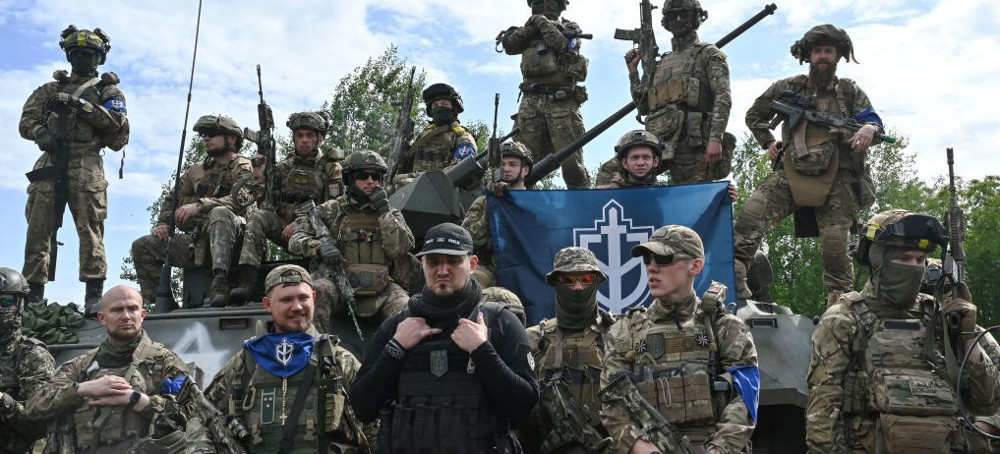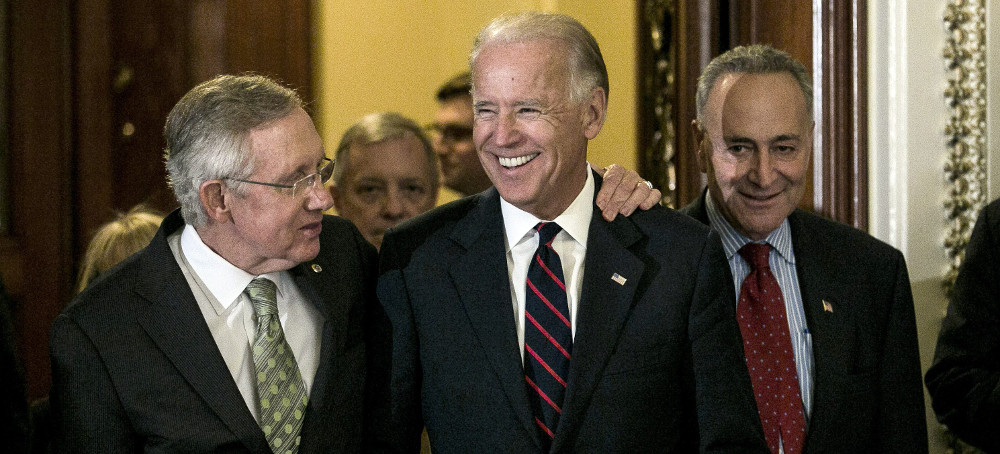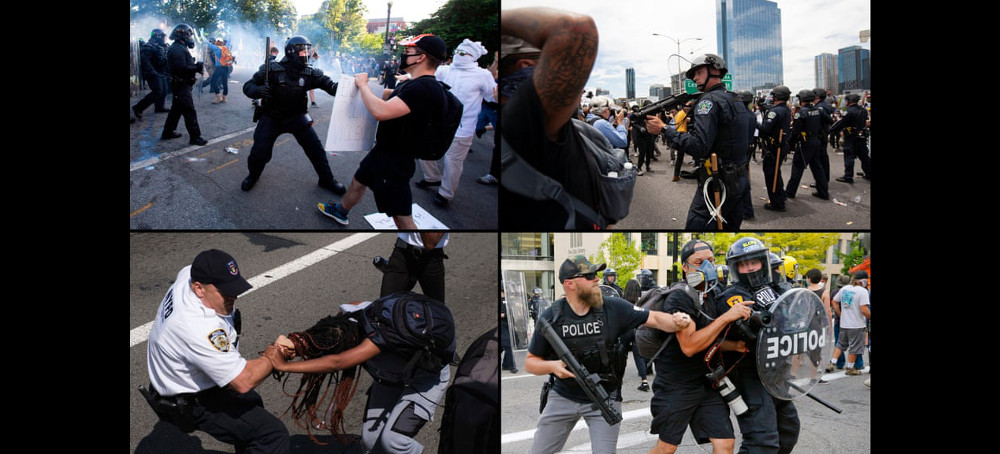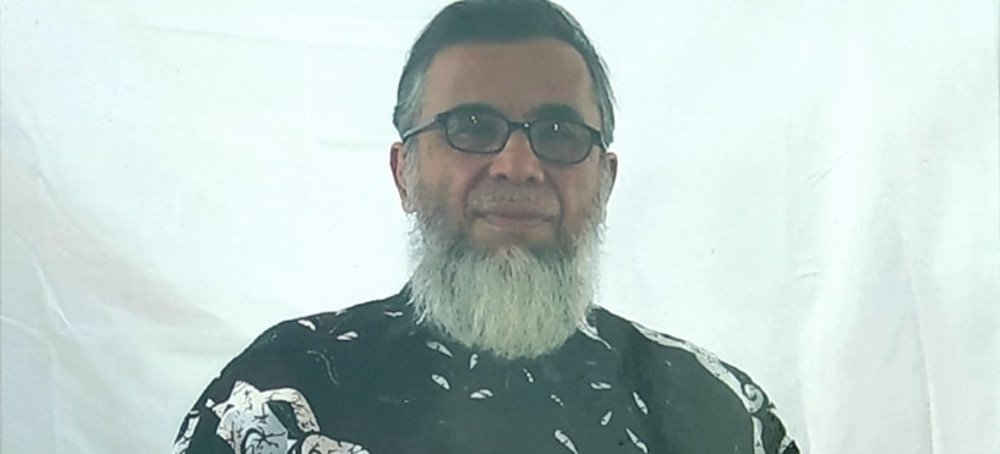Live on the homepage now!
Reader Supported News
An untold story in the history of American torture
President George W. Bush praised the arrest in a speech three days after it happened. He called Hambali “one of the world’s most lethal terrorists” and said: “He is no longer a problem to those of us who love freedom.” A few weeks later, it was reported that the US had given $10 million to the Thai security forces; the funds were to be shared among those responsible for Hambali’s capture. Three of Hambali’s alleged accomplices in one of the bombings were sentenced to death and a fourth, who apologized and expressed remorse—he also claimed that Hambali had no prior knowledge of the bombings—is still in prison.
In his speech Bush also asserted that Hambali was a “close associate” of Khalid Sheik Mohammed, known as KSM, an early American arrest in the war on terror. KSM, who is still detained at Guantánamo, was said to have revealed that Hambali met with Osama bin Laden and was Al Qaeda’s point man for research on biological weapons. The American press was told that during the summer of 2001 Hambali was teaching the essentials of biological warfare at an Al Qaeda training camp near Kandahar in Afghanistan.
The leaks kept coming. Hambali was said to have confessed what he knew of Al Qaeda’s worldwide operations and to his involvement in terrorism attacks in Southeast Asia. On October 9, 2003, CBS news, citing summaries of American interrogations, reported that Hambali was “implementing plans” involving “biological weapons, most likely anthrax.” The network said he was likely trying to open a biological weapons plant with the support of Al Qaeda.
In December, the Chicago Tribune, citing American intelligence officials, reported that Hambali “began cooperating almost immediately, enabling them to thwart planned attacks in the region and break up terrorist cells. Within a few weeks, Hambali allegedly began talking about Al Qaeda’s effort to develop chemical and biological weapons. . . . One reason US officials are taking the allegations so seriously is that Hambali’s cooperation has been so strong.”
Hambali arrived at Guantánamo on September 4, 2006, after three years and fifteen days of detention at CIA black sites. I learned that the interrogation tactics he was subjected to there had become an issue of bitter controversy among CIA officers. It took months of reporting before I learned the outline of a story being circulated at the highest levels of the agency about the extreme things an agent in the field might have done on his own to Hambali. His actions were the subject of an agency inquiry that went nowhere.
READ MORE The question for the justices was how to determine which wetlands qualify as such waters. (photo: Erin Schaff/The New York Times)
The question for the justices was how to determine which wetlands qualify as such waters. (photo: Erin Schaff/The New York Times)
The justices ruled that many wetlands are not covered by the Clean Water Act.
Justice Samuel A. Alito Jr., writing for five justices, held that the law covers only wetlands “with a continuous surface connection” to those waters.
The decision was a second major blow to the E.P.A.’s authority and to the power of administrative agencies generally. Last year, the court limited the E.P.A.’s power to address climate change under the Clean Air Act.
READ MORE  The commander of the Russian Volunteer Corps, Denis Kapustin (C), known as White Rex, flanked by fighters in camouflage. (photo: Sergey Bobok/AFP)
The commander of the Russian Volunteer Corps, Denis Kapustin (C), known as White Rex, flanked by fighters in camouflage. (photo: Sergey Bobok/AFP)
A few days after a successful incursion inside Russia's Belgorod Oblast, those who took part wanted all the attention they could get.
The Russian militia groups, who call themselves the Russian Volunteer Corps (RVC) and the Free Russia Legion, say they have been fighting alongside Ukraine in some of the hottest spots of the war, including Ukraine's Donbas.
They now claim to have attempted to bring the fight into Russia, even if for a short while.
While many details of the operation still remain unclear, the cross-border incursion into Belgorod Oblast, which borders Ukraine, appears to have been the boldest operation since the start of Russia's full-scale invasion.
In early March, the Volunteer Corps' incursion into Russia's Bryansk Oblast was a similar yet much shorter endeavor.
Denis Kapustin, also known by his alias White Rex and ties to the Russian far-right, leads the so-called Volunteer Corps.
He said the operation that began on May 22 ended a day later when an undisclosed number of soldiers returned to Ukraine. He claimed his troops only suffered two light injuries.
"I think that any crossing of the state border with the Russian Federation and a successful return can certainly be called a success," Kapustin told journalists.
According to him, his group held "around 42 square kilometers" of land in Russia for "quite a while" during the operation.
When asked by the Kyiv Independent what the Volunteer Corps wants to prove to the Russian public with these operations, Kapustin said it is the vulnerability of the Kremlin regime and that Russian President Vladimir Putin's powers are "not unlimited."
"I want to prove to (Russians) that it's possible to fight against a tyrant," Kapustin said. "The FSB (Federal Security Service) can beat, control, and torture unarmed (Russian citizens). But as soon as they meet with full-fledged armed resistance, they run away."
To convey their message to the Russian people, the group consulted with the Ukrainian military and received some tangible help – such as medical support for wounded soldiers, Kapustin told the Kyiv Independent.
But much is unknown about the two Russian units said to be fighting for Ukraine, including their size and what roles they have taken during the war so far.
The Ukrainian public has been rather skeptical of the units' participation in active fighting due to a lack of visual evidence, with some also questioning why there is no report of their casualties.
While the units claimed responsibility for the incursion, Russia immediately accused the Ukrainian military's "sabotage group" of launching a cross-border assault – a claim immediately denied by Kyiv.
The two units say they work with Ukraine's military within its ranks, but "everything we do, every decision we make behind the state border is our decision," Kapustin explained.
It's unlikely that such a complex operation could have been possible without Ukraine's direct military command.
Days after the incursion, the biggest question remains the origin of U.S.-made Humvee and MaxxPro military trucks – shown in videos and images – that allegedly ended up in Russia. The U.S. has provided the same vehicles to Ukraine as part of its $37 billion in military aid.
Ukraine denies any involvement in providing the weapons.
During the meeting with journalists on May 24, Kapustin denied the involvement of Western equipment or weapons within his group.
The White House has said it is now investigating the reports that "U.S. equipment and vehicles could've been involved" in the fighting within Russian borders.
A top Ukrainian official, willing to stay anonymous to speak freely, said that the U.S. didn't contact Ukraine's leadership concerning the Belgorod incident.
Russian Volunteer Corps
About 20 soldiers, some with their faces covered with balaclavas, stood together in front of an armored military vehicle, a "military trophy" they claim to have brought back from their latest operation inside Russia.
Only one representative from each Russian unit spoke to journalists.
Kapustin's Russian Volunteer Corps, which he says was established on Aug. 22, 2022, is a volunteer unit largely composed of ethnic Russian emigrants who have lived in Ukraine or abroad.
While founded much later, Kapustin said that some volunteers have fought in the war since 2014 and the early months of the 2022 invasion. The Volunteer Corps was said to be established in order to make it easier for Russian nationals to join the fight against Moscow's invading army.
Kapustin told the Kyiv Independent that the corps continues to receive many applications, claiming that its popularity rose just as Moscow announced mobilization in September 2022. He said, "When mobilization began in Russia, we received 200 applications per day."
The corps fighters' age varies from 19 to mid-40s, according to Kapustin, who himself is in his late 30s.
Kapustin, who goes by the nom de guerre named after his white supremacist clothing brand White Rex, is also known as a former mixed martial arts fighter and for his connections to other neo-Nazi organizations around the globe.
Free Russia Legion
The other military unit, Free Russia Legion, was founded much earlier, on March 11, 2022.
In April that year, three now-former Russian soldiers – who did not reveal their names – held a press conference in Kyiv, where they said they had found out about the legion when they were held in Ukrainian captivity as POWs and chose to join after witnessing Russia's brutality in the war against Ukraine.
The legion's spokesman goes by his call sign Tsezar (Caesar).
According to Tsezar, civil war is brewing in Russia amid growing support for groups like the Free Russia Legion and the Russian Volunteer Corps. He insisted that the fighters are simply "peacekeepers" in Ukraine, whose priority remains helping Kyiv win the war.
He claimed that destabilizing Russia was not in his group's interests.
"I just want to go home and live in peace," Tsezar, a 49-year-old from St. Petersburg, said. "I want Russia to stop bombing Ukraine, I just want Russia and Ukraine to live in peace."
Tsezar described the legion as "more centrist" than the right-wing Russian Volunteer Corps. The legion is reportedly largely made of prisoners of war who were captured in Ukraine and former military personnel with experience and knowledge of Russian military tactics.
" We will change Russia, freeing the territory and creating centers of new Russian power there," Tsezar told the Kyiv Independent, repeating the narrative that Russia is "occupied" by the Kremlin regime.
"We know that the people support us, and every day this support is increasing," he added.
Participation in groups such as the corps and the legion is punishable by law in Russia. It violates at least two articles of Russia's Criminal Code for acting against state interests, each bringing a potential prison sentence of up to 20 years.
In March this year, the Russian Supreme Court recognized the Free Russia Legion as a "terrorist organization whose activities are prohibited on the territory of the Russian Federation," Russian Interfax reported.
Ongoing operation
Just days after the cross-border incursion in Belgorod Oblast, much is still unclear about the operation.
Tsezar, from the Free Russia Legion, said that the task was "to carry out deep reconnaissance in combat" and not to reach Belgorod city, the regional center.
His legion claimed in the afternoon on May 22 that it had "liberated" the border village of Kozinka with the Russian Volunteer Corps and entered the neighboring Graivoron town.
Russian authorities claimed that a cross-border Ukrainian shelling in the morning occurred just before the fighting broke out.
The Kyiv Independent could not independently verify these claims.
The incursion showed that "the military-political leadership of the Russian Federation is absolutely not ready for such things," Kapustin told journalists.
By the evening, the local authorities had announced a "counter-terrorist operation" in Belgorod Oblast and that the "majority" of residents in bordering villages had fled their homes.
While Russia says it has strengthened its defense in bordering regions, the incursion suggests otherwise. Belgorod Oblast authorities reportedly spent nearly 10 billion rubles (about $125 million) on "the construction of protective structures" in 2022, Russian Interfax news reported in February, citing the regional construction minister Oksana Kozlitina.
The Kremlin framed what it claimed was an incursion of Ukrainian saboteurs as Kyiv's attempt to distract attention from its loss of Bakhmut – a city in eastern Ukraine essentially captured by Russia after suffering enormous casualties amid more than ten months of heavy fighting.
Ukraine denied the Russian accusations, with the military intelligence saying that only the two Russian volunteer units were involved.
Senior Ukrainian officials, including President Volodymyr Zelensky, remained silent on the Belgorod combat operation. A top Ukrainian official, willing to stay anonymous to speak freely, confirmed the knowledge of such an operation beforehand.
It remains unclear whether the Russian anti-government groups captured any villages on May 22 or May 23, according to the analysts at the Institute for the Study of War (ISW), a D.C.-based think-tank analyzing the war in Ukraine.
Kapustin from the Russian Volunteer Group, however, said on May 24 that the operation is "ongoing."
"It definitely has various phases, so phase one, we consider it a successful phase – it's over now," he explained. "But the operation is ongoing, that's what I can say for now."
"It's only the beginning," he added. "The Russian-Ukrainian border is pretty long, so yet again, there will be a spot where things will get hot," Kapustin said, promising more attacks in the future.
READ MORE  Former U.S. Sen. Harry Reid, D-NV, left, and U.S. Sen. Chuck Schumer, D-NY, right, leave the Senate chambers with U.S. Vice President Joe Biden on July 25, 2012, in Washington, D.C. (photo: T.J. Kirkpatrick/AFP)
Former U.S. Sen. Harry Reid, D-NV, left, and U.S. Sen. Chuck Schumer, D-NY, right, leave the Senate chambers with U.S. Vice President Joe Biden on July 25, 2012, in Washington, D.C. (photo: T.J. Kirkpatrick/AFP)
Biden negotiating a debt ceiling with Kevin McCarthy was Harry Reid’s worst nightmare.
For months, Biden insisted that he wouldn’t ever be in that room, because he simply wasn’t going to negotiate with Republicans over lifting the debt ceiling. But he also poured cold water on invoking the 14th Amendment or minting a trillion-dollar platinum coin, which handed Republicans all the leverage. Biden also had the chance to lift the debt ceiling at any point from January 2021 until last December when Democrats still controlled both houses of Congress. Sen. Tim Kaine, D-Va., recently told Politico not doing so is one of his biggest regrets.
Instead, Biden went into negotiations with congressional Republicans without a serious offer of his own. He made a few half-hearted suggestions that a better way to cut the deficit is to target hedge fund managers and the superrich. But when Republican House Speaker Kevin McCarthy objected, he dropped it. Talks continued at the White House between McCarthy and Biden Monday evening. But with Biden now negotiating the size of the cut, Democrats’ only hope is that Republicans can’t agree and fail to seize the moment.
All of this is reminiscent of the last time Biden, as vice president, intervened in high-stakes Capitol Hill negotiations. Afterward, Senate Majority Leader Harry Reid ordered the White House to never send him down again. He did such a bad job that he got a worse deal out of Minority Leader Mitch McConnell than McConnell had already agreed to give Reid. I covered this moment in my last book, “We’ve Got People: From Jesse Jackson to AOC, the End of Big Money and the Rise of a Movement,” which was excerpted in The Intercept.
It all came at the end of 2012, and the circumstances were similar. President Barack Obama had just stomped Republican Mitt Romney at the polls in a post-Occupy campaign that centered on economic inequality. Democrats picked up two seats in the Senate, expanding their majority to 53 and adding Elizabeth Warren to their ranks. Though Democrats won more House votes nationwide and picked up a net of eight seats, Republicans held onto the House narrowly.
The major tax cuts pushed through by President George W. Bush were set to expire at the end of 2012, creating what was called a fiscal cliff. If Congress did nothing, taxes would go up on everybody. Reid told me in an interview for “We’ve Got People” that going over the cliff was precisely his plan. Reid said, “I thought that would have been the best thing to do because the conversation would not have been about raising taxes, which it became, it would have been about lowering taxes.”
In other words, let all the rates go up and then bargain with Republicans to reduce taxes just for middle class and poor people. McConnell similarly knew the difficult position going over the cliff would put him in, and in talks with Reid, he agreed to let rates on people making more than $250,000 per year go back up.
Reid felt like he had successfully pushed McConnell to the brink; McConnell had a strong sense that Reid intended to go over the cliff and put Republicans up against a wall. It was now Sunday, December 30, 2012, and Democrats only had to hold out until Tuesday to find themselves in a dramatically improved political position, as the dawning of the new year would mean the tax cuts expired and automatically reverted to pre-Bush levels. At that point, it would be Republicans who would be left pleading for rate cuts.
In desperation, McConnell reached out directly to Vice President Biden, calling him on the phone and explaining that Reid was refusing to be reasonable. Over the course of the day, McConnell and Biden struck a deal. A senior Republican aide told me, “Biden gave Republicans everything they wanted in exchange for fixing the fiscal cliff problem.”
Just like today, the fiscal cliff was only a problem because Biden allowed it to be. Reid would have been happy to drive the car off the cliff and then fight it out amid the wreckage.
In the same way, Biden could have just ignored the debt ceiling, invoked the 14th Amendment, declaring the debt ceiling unconstitutional, and dared Chief Justice John Roberts to blow up the global economy. McCarthy himself would publicly complain but be privately relieved that he had gotten through this moment with his speakership intact. Future presidents would thank Biden. If future Congresses wanted to rein in spending, they could rein in spending. But they could not threaten the global economy to do it.
On the morning of New Year’s Eve back in 2012, Reid was still feeling good about his position, still ignorant of what Biden had given away. Then McConnell took to the Senate floor and announced that he’d been in talks with the vice president, they were progressing well, and he was hopeful that they’d have legislation to move by the end of the day.
As details of the deal began leaking out, progressive Democratic senators were floored. A large group of them — including Sens. Bernie Sanders of Vermont, Sherrod Brown of Ohio, Jeff Merkley of Oregon, Sheldon Whitehouse of Rhode Island, Al Franken of Minnesota, and Tom Harkin of Iowa — stormed over to Reid’s office.
The deal was awful, they told Reid, and it had to be stopped. Reid told them what had happened, that it was out of his hands and that McConnell had gone around him to Biden. He said he was working on improving it and would be in touch throughout the day.
None of the senators had any business scheduled — it was New Year’s Eve, after all — so Sanders invited them back to his office in the Dirksen building. The Hart building had a popcorn machine, so Harkin asked his staff to bring some by. The crew ended up spending several hours together in Sanders’s office, thinking through potential strategies of opposition and waiting to hear from Reid.
Instead, one senator’s phone rang, and it was Biden, calling to sell the deal he had cut. In classic Biden fashion, he offered a 10- to 15-minute soliloquy, a meandering argument that largely boiled down to, “You can trust me; I’m your friend; this is a good deal.” The senator could barely get a word in before the conversation ended.
Moments after he hung up, another cellphone rang, and it was Biden again. Unaware that the group was all together, Biden proceeded to call each of them, one after the other, delivering the same spiel.
Ultimately, it fell to Reid to drag the progressive senators into line. Once it was clear that the White House was on board with Biden’s deal and McConnell was all in, that meant that there would be at least 70 or 80 votes for it. The progressive bloc could vote no, but it would only send a message of discord and have no effect on the outcome, Reid told them, coaxing them to support the deal he himself loathed. In the end, all the progressive senators except Harkin voted for the deal. It passed 89-8.
Years later, Reid still regretted how it went down. He told me, “If we’d have gone over the cliff, we’d have had resources to do a lot of good things in the country — infrastructure development — but it didn’t work out that way.” Letting all the tax rates go back to pre-Bush levels would have yielded the Treasury around $3 trillion over 10 years. Without the deal, taxes on dividend payments to the rich would have been set at 39.6 percent. Under the terms of the deal, they would be set at 20 percent, meaning that the superwealthy would be paying lower tax rates on their passive dividend income than many working people would pay on their wages. It helped fuel the inequality that keeps getting worse and added trillions to the debt at the same time.
Now Biden has another chance to be in the room, and so far, he’s getting outmaneuvered by McCarthy.
READ MORE  'I have never seen a wave of settlements for police brutality like this in American history,' said Justin Hansford, a professor at Howard University School of Law. (photo: AP)
'I have never seen a wave of settlements for police brutality like this in American history,' said Justin Hansford, a professor at Howard University School of Law. (photo: AP)
Exclusive: At least 19 cities will pay settlements to protesters who sustained injuries as a result of law enforcement action
The brutal murder of George Floyd by Minneapolis police officers on 25 May 2020 sparked the largest nationwide demonstrations since the civil rights era, as upwards of 26 million people gathered to protest racism and police brutality.
But, three years later, at least 19 US cities will pay more than $80m total to protesters who sustained various injuries as a result of law enforcement action, ranging from being teargassed to being shot with projectiles, and have filed dozens of civil lawsuits.
Justin Hansford, a professor at Howard University School of Law and executive director of the Thurgood Marshall Civil Rights Center, called the total number of settlements “unprecedented”.
“I have never seen a wave of settlements for police brutality like this in American history,” he said.
Thousands were traumatized, some were permanently injured and have sued successfully.
“You don’t recover from something like this. That’s not a thing you do,” said Linda Tirado, who was partially blinded after being fired on by the police while covering the protests that engulfed Minneapolis as a journalist.
Anthony Evans was shot in the jaw in Austin by police using so-called less-than-lethal ammunition during a Black Lives Matter protest in the Texas capital in 2020.
“We were never, like, cussing or yelling in their face or anything. It was all just peaceful,” Evans said.
Carol Sobel, a civil rights attorney in southern California, said that ongoing litigation in the US, which can take years to resolve, is expected to further boost the national payout total.
“As I see this now, when all of these cases are concluded, it will probably be a record amount, total, paid out across the country,” said Sobel, as well as a record number of settlements.
“That’s a consequence of the fact that the outrage of the killing of George Floyd was national and was represented nationally in a way that has never occurred before,” she said.
Other cities, including New York, Philadelphia, Denver, Atlanta, Los Angeles, Oakland, Milwaukee, Kansas City and Portland, Oregon, are among at least 19 to have agreed settlements so far and many more are being sued coast to coast, including San Jose and Washington DC.
“There are a lot of pending cases,” said Mara Verheyden-Hilliard, executive director of the Center for Protest Law and Litigation. “I think it’s reasonable to expect that numbers will eclipse past numbers,” she said.
Verheyden-Hilliard noted that mass settlements were paid out for police violence experienced during the Occupy Wall Street movement in 2011 and 2012 and for police using excessive force during anti-globalization protests in the early 2000s. Then came 2020.
“We had millions of people flowing into the street to stand against racist police violence. And in city after city and small town after small town, law enforcement was deployed to violently repress demonstrators,” Verheyden-Hilliard said.
It is unclear exactly how many people were injured by police while participating in protests that erupted after video emerged of a white police officer kneeling on Floyd’s neck during an attempted arrest, while Floyd repeatedly gasped that he couldn’t breathe.
Demonstrations spread across the country and then internationally, prompting a fresh reckoning in public life about systemic racism and the disproportionate killing of Black Americans by the police. Cities large and small have since paid out millions for injuries as heavily militarized police used rubber bullets, teargas and other weapons, and methods such as kettling, to corral and subdue or deter protesters.
New York City and its police department (NYPD) will pay upwards of $6m to 320 protesters who were subject to excessive force – including being zip-tied, hit with batons and pepper-sprayed – during a June 2020 protest.
“The violence unleashed upon us that night was intentional, unwarranted, and will be with me for the rest of my life,” said Henry Wood, a plaintiff, in a March statement about the settlement.
“What the NYPD did, aided by the political powers of New York City, was an extreme abuse of power.”
The sum of $9.25m was paid to hundreds of Philadelphia protesters. La Mesa, California, awarded a local woman $10m after an officer shot her in the head with a projectile.
The payments, usually involving a lengthy legal process for victims, are conditional on cities and their respective police departments admitting no wrongdoing.
All the while, victims face life-changing injuries, trauma and other burdens.
Hansford noted that severe injuries like Tirado’s and Evans’ make up the majority of settlement cases, while many more never see redress.
Even people who do receive settlements face financial challenges, said Hansford. There can be high legal fees and medical debt, and settlements may not cover counseling or ongoing assistance.
“You’ll be lucky to break even in most cases if you don’t get damages,” said Hansford, referring to additional funds awarded for emotional harm.
Hansford added that, historically, litigation has done little to curb excessive force and police departments face no direct financial consequences.
“They’ll pay those dollars with the knowledge that it won’t really impact them,” said Hansford.
Individual officers are also largely spared from criminal charges.
Verheyden-Hilliard said that some settlements can get controversial police tactics banned. But she noted that police routinely find new ways to challenge reforms.
“It takes another wave of lawsuits to try and put constraints or dismantle the unlawful tactics that we see,” she said.
Since George Floyd’s murder, many more have criticized the US’s failure to address police brutality. The Minnesota congresswoman Ilhan Omar, in a Guardian interview earlier this month, criticized the lack of action and said the problem had only increased. And the UN has called on US officials to address police violence against Black people.
READ MORE  Doctor Caitlin Bernard (right) arrives with Honeybee Health founder Jessica Nouhavandi to the Time 100 NEXT Gala in October, after the story of a 10-year-old rape victim propelled her to national attention. (photo: Caitlin Ochs/Reuters)
Doctor Caitlin Bernard (right) arrives with Honeybee Health founder Jessica Nouhavandi to the Time 100 NEXT Gala in October, after the story of a 10-year-old rape victim propelled her to national attention. (photo: Caitlin Ochs/Reuters)
For nearly a year, Indiana’s Attorney General Todd Rokita (R) pursued punishment for Caitlin Bernard, an OB/GYN and an assistant professor at the Indiana University School of Medicine who carried out the abortion in June 2022, less than a week after Roe v. Wade was struck down, enacting trigger laws.
Bernard broke patient privacy laws by telling an Indianapolis Star reporter about the patient’s care, the board decided Thursday night after a roughly 14-hour hearing that ended shortly after 11:30 p.m. Bernard’s lawyers argued she properly reported the incident to an Indiana University Health social worker and did not run afoul of privacy laws when she discussed the patient’s case in a general and “deidentified” manner that is typical for doctors.
Records obtained by The Washington Post last year show that Bernard reported the girl’s abortion to the relevant state agencies ahead of the legally mandated deadline, which the board agreed with Thursday night, clearing her of a charge related to that issue.
Attorneys for Bernard did not immediately make a statement after the board’s late-night decision. Rokita, meanwhile, issued a statement praising the board’s decision to discipline Bernard.
“Like we have said for a year, this case was about patient privacy and the trust between the doctor and patient that was broken,” he said.
Bernard’s lawyers rejected Rokita’s allegations as baseless and politically motivated. The seven-member board of governor appointees could, by a majority vote, have either taken no action against Bernard or imposed a range of disciplinary measures up to and including the immediate termination of Bernard’s medical license.
Throughout the lengthy hearing, Bernard faced at times pointed questions about her decisions.
She explained how, as a doctor, she felt she had “an obligation” to ensure Hoosiers understood how abortion bans were affecting people across the country — and could eventually affect them.
Bernard was also asked whether she thought she would have “gotten as much attention” if she had not mentioned the 10-year-old patient’s case to a reporter.
“I don’t think that anybody would have been looking into this story as any different than any other interview that I’ve ever given if it was not politicized the way that it was by public figures in our state and in Ohio,” Bernard said.
Cory Voight, an attorney with Rokita’s office, framed Bernard’s actions as undermining trust in medical professionals and medical privacy and accused her of being “brazen in pursuit of her own agenda” in his opening statement Thursday.
“This is about privacy and trust. Privacy is the foundation, as you know, of health care. It’s something upon which patients rely,” Voight said.
Alice Morical, one of the attorneys for Bernard, was unequivocal in her opening statement that Bernard followed policy and complied with Indiana law.
“Dr. Bernard could not have anticipated the atypical and intense scrutiny that this story received,” Morical said. “She did not expect that the politicians would say that she made the story up. She did not expect that people would say that the reporter didn’t have sufficient information. The politicalization of this [is] what caused this issue to continue to grow and be a focus.”
Several doctors in white coats were seen entering the hearing room Thursday to sit in support of Bernard.
The hearing extended into the evening, with witnesses testifying in person and online.
Rokita’s office drew notice from local reporters for the unusual move to bring in outside counsel from a Washington law firm for a medical licensing board hearing. With his deputies arguing on the state’s behalf, Rokita did not attend Thursday’s hearing — but appeared to be watching it remotely as he tweeted comments.
Questioning focused on whether Bernard broke medical privacy laws. A state witness and expert in privacy compliance, Andrew Mahler, said he thought Bernard violated the Health Insurance Portability and Accountability Act, known as HIPAA.
Mahler, who used to work for the federal Office of Civil Rights, said Bernard violated HIPAA when she told a colleague general details of the case at a rally, and when she did the same to a reporter, disclosing information that Mahler said could have conceivably identified the 10-year-old.
But the HIPAA expert called by Bernard’s attorneys disagreed.
“The information that she shared was age, gender and state,” said Paige Joyner, who has done hundreds of HIPAA risk assessments and also used to work in the Office of Civil Rights. “That’s not protected health information. There was nothing that was individually identifiable.”
The 10-year-old’s case garnered international attention when it first came to light in a July Indianapolis Star story about pregnant patients coming to Indiana in response to abortion restrictions elsewhere due to trigger laws enacted in the wake of the U.S. Supreme Court’s decision in Dobbs v. Jackson Women’s Health Organization in June.
The story instantly became a political lightning rod, with abortion rights advocates citing it as an immediate and horrific example of how the end of federal abortion protections was harming women and girls, while antiabortion Republicans dismissed the story as fictitious. But two weeks later, a 27-year-old Ohio man was arrested for felony rape after allegedly confessing to the crime.
Bernard sued Rokita last year, alleging in her suit that his office relied on “facially invalid consumer complaints to justify multiple, duplicative, and overbroad investigations into law-abiding physicians.”
An Indiana judge in December denied Bernard’s request to block Rokita’s efforts, saying it was a matter for the state licensing board. But Marion County Judge Heather Welch also said Rokita acted unlawfully by making public comments about investigating Bernard for potential wrongdoing — a violation of his office’s confidentiality requirements.
READ MORE  A solar energy field next to the Lippendorf coal-fired power plant in Lippendorf, Germany. (photo: Jens Schlueter/EPA)
A solar energy field next to the Lippendorf coal-fired power plant in Lippendorf, Germany. (photo: Jens Schlueter/EPA)
According to the World Energy Investment report, the global energy crisis that followed Russia’s invasion of Ukraine, as well as the growing affordability of renewables, has given rise to more sustainable alternatives, sparking a rise in investments.
“Clean energy is moving fast – faster than many people realise. This is clear in the investment trends, where clean technologies are pulling away from fossil fuels,” said IEA Executive Director Fatih Birol in an IEA press release. “For every dollar invested in fossil fuels, about 1.7 dollars are now going into clean energy. Five years ago, this ratio was one-to-one. One shining example is investment in solar, which is set to overtake the amount of investment going into oil production for the first time.”
In 2023, approximately $2.8 trillion will be invested in energy globally, the report said. More than $1.7 trillion of that amount is projected to be invested in green energy technologies like electric vehicles (EVs), renewables, power grids, nuclear energy, heat pumps, low-emissions fuels and improvements in energy efficiency. The remaining more than $1 trillion will be invested in gas, oil and coal.
Yearly investments in renewables are predicted to increase by 24 percent from 2021 to 2023, while fossil fuel investments are expected to rise just 15 percent. Advanced economies, as well as China, are responsible for more than 90 percent of the growth, which could jeopardize global energy equality if green energy investment increases aren’t seen in other parts of the world.
“Weak grid infrastructure is a limiting factor for renewable investment in many developing economies, and here too current investment flows are highly concentrated. Advanced economies and China account for 80% of global spending and for almost all of the growth in recent years,” the report said.
Renewable energy technologies are projected to make up nearly 90 percent of power generation investment this year, led by solar energy.
Investments in solar are expected to reach more than $1 billion per day this year, for a total of $382 billion in 2023, reported Reuters. Oil production investment is projected to be $371 billion.
“This crowns solar as a true energy superpower. It is emerging as the biggest tool we have for rapid decarbonisation of the entire economy,” said Dave Jones, energy think tank Ember’s head of data insights, as Reuters reported.
EV sales are projected to rise by one-third in 2023, following a jump last year, the press release said. Since 2021, sales of heat pumps worldwide have also grown by double digits.
New initiatives like the U.S. Inflation Reduction Act and policies in Europe, China, Japan and other countries, as well as phases of vigorous economic growth coupled with unstable fossil fuel prices have helped prompt investments in clean energy.
Oil and gas upstream spending is projected to increase by seven percent this year, primarily by large Middle Eastern national oil companies.
New fossil fuel investments will increase by six percent to $950 billion this year, according to the IEA report.
The increase in fossil fuel investments will lead to levels this year that are more than twice where they need to be in 2030 to be on track for the Net Zero Emissions by 2050 Scenario laid out by the IEA, the press release said.
Last year, demand for coal was at a record high. In 2023, investment in coal is on a trajectory for a six-fold increase over the levels forecast to reach net zero goals for 2030.
“Investment in coal supply is expected to rise by 10% in 2023, and is already well above pre-pandemic levels. Investment in new coal-fired power plants remains on a declining trend, but a warning sign came in 2022 with 40 GW of new coal plants being approved – the highest figure since 2016,” the report said.
The largest green energy investment deficiencies were found to be in developing and emerging nations. Higher interest rates, weak grid infrastructure, high capital costs, obscure policy rules and strained utilities have hampered investments in renewables in those countries.
“The irony remains that some of the sunniest places in the world have the lowest levels of solar investment,” Jones said, as reported by Reuters.
Follow us on facebook and twitter!
PO Box 2043 / Citrus Heights, CA 95611


